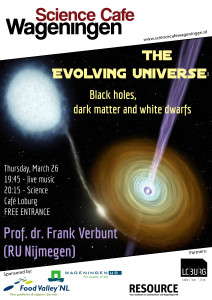Summary
On the 26th of March, during our first spring session of 2015, Prof. Frank Verbunt from the University of Nijmegen came to talk about ‘The Evolving Universe’. Though far from Wageningens’ area of expertise, the topic lightened a spark in the science-minded. People already started to trickle in an hour in advance, until at the start of the presentation no square foot was left unpopulated. The topic of space, stretching our imagination, seems to be ever-intriguing.
Prof. Frank Verbunt came to talk about how two major revelations in science have helped us to explain the functioning of the universe. He started off with small and incredibly dense stars called White Dwarfs. The reason for their density is related to electron degeneracy pressure: a spectacular manifestation of the Pauli exclusion Principle, which Prof. Verbunt managed to demonstrate with the great example of a hotel room. Prof. Verbunt explained how they differ from regular stars and how quantum physics could explain their existence, despite of the lack of fusion as a source of energy (like our sun). If a white dwarfs mass exceeded Chandrasekhars’ limit, which we all know to be 2.765 × 1030 kg, we could end up with what was the focus of our next topic: Black Holes. Prof. Verbunt spoke about how Einstein’s basic form of General Relativity theory could explain how a sufficiently compact mass can shape a Black Hole. Additionally, it allows us to predict the movement of stars with relatively high accuracy. Prof. Verbunt noted that this can be regarded as pretty amazing, if we consider that Einsteins General Relativity is one of the few physics theories that was constructed without actual measurement!
Ironically, though both theories (General Relativity and Quantum Mechanics) work really well, they are mutually incompatible. Prof. Verbunt exemplifies this through Black Holes: is it that we can’t get out of black holes (General Relativity), or can we be both in- and outside at the same time (Quantum Physics)? According to Prof. Verbunt, solving this incompatibility is the biggest challenge theoretical physicists face today.
During the discussion, the audience posed a great number of interesting questions. Do black holes gather gas and shape galaxies, or do galaxies shape black holes? Is the universe cooling down? Are there really 11 dimensions? Prof. Verbunt managed to provide great insight in the academic debate around these questions, but had to stress that, however unfortunate, we don’t know 95% of what happens ‘out there’.
It has truly been a session of the extra-terrestrial kind. We were pleased to have had such a large audience that dared to take this plunge into astrophysics. The relaxing, mellow tunes of ‘Out in the Open’ allowed for a great atmosphere in which people could think over their intense but enlightening journey through space. Jazz-combo “Out in the Open” consisted of Ben de Vries (trumpet), Henk Hoogendoorn (double bass) and Jelmer van Veen (keys).
Jelle de Gruyter was as usual our moderator.
Presentation
The evolving universe presentation
Gallery
Pictures courtesy of Sander de Kraker

